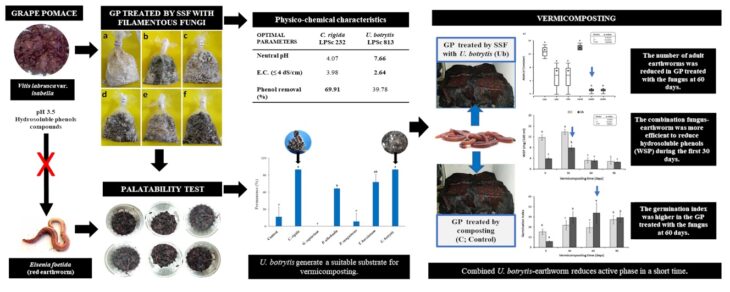Grape pomace transformed by specific fungi has the potential as a promising substrate for vermicomposting
Authors
-
Mar´ıa Ines Troncozo
*
 1, 2
1, 2
- Mart´ın Eduardo Escaray 2
- Mar´ıa Florencia Vianna 1
- Mario C. N. Saparrat 1, 2, 3
Abstract
Purpose: It is known that the combination of bioprocesses can contribute to obtaining better results compared to those achieved by applying each process individually. Solid state fermentation of Vitis labrusca grape pomace was carried out using different saprotrophic fungi following a vermicomposting process.
Method: A palatability test was performed to evaluate the permanence of Eisenia foetida adults on pomace transformed by fungi. Subsequently, pomace treated with Ulocladium botrytis LPSc 813 was vermicomposted for 90 days to evaluate comparatively the earthworm population dynamics and different physio-chemical and biological parameters with respect to control treatment.
Results: The pomace treated with Coriolopsis rigida LPSc 232 and U. botrytis showed a 100% permanence of the earthworms, though only this last fungus was able to modify the acidity of the parent grape pomace (pH 7.66 ± 0.84) without increasing its salinity. The combination of U. botrytis-vermicomposting showed a reduction in the adult and juvenile earthworm number at 60 days and presented a higher germination index compared to the control.
Conclusion: Results suggest that grape pomace pretreated with U. botrytis could be an optimal starting substrate for vermicomposting, obtaining an organic fertilizer in a short period.
Highlights
- Fungal treatment facilitates earthworms’ tolerance to grape pomace.
- U. botrytis generates a suitable substrate for vermicomposting.
- The combined activity of U. botrytis and earthworms might be an alternative strategy to reduce the vermicomposting process.




